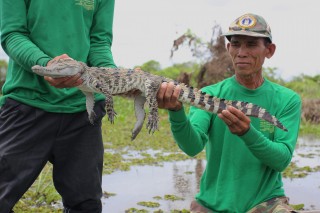Endangered Siamese Crocs Released in Wild

WCS Lao PDR Members of the Village Crocodile Conservation Group release a Siamese crocodile into the total protection zone of the Xe Champhone wetland complex.
The Wildlife Conservation Society announced today the successful release of 17 juvenile critically endangered Siamese crocodiles into a protected wetland in Lao PDR.
The one-to-two-year-old crocodiles, which range between 50-100 cm (20-39 inches) in length, were raised in facilities managed by local communities working with WCS to protect the endangered reptiles and their habitat.
The juvenile crocodiles were released this week into the Xe Champhone wetland, Than Soum village, Savannakhet Province. This is one of two RAMSAR wetland sites in the country. Lao PDR became a signatory to the RAMSAR convention in 2010.
A ceremony observing cultural traditions was held prior to the release and involved participants from local communities, government and WCS staff. Local communities have traditional beliefs about Siamese crocodiles, and events on the day included welcoming the crocodiles to the village area and wishing both them and community residents good luck in the future.
Following the completion of the release ceremony, the crocodiles were transported by boat into the heart of the wetland complex that is managed by local communities to provide habitat and protect the species.
It is estimated that there may be fewer than 1000 Siamese crocodiles remaining in the wild, with a significant proportion of this population located in Lao PDR.
The release of these crocodiles is the culmination of several years of conservation action implemented by WCS, local communities, and the Government of Lao PDR, Ministry of Natural Resources and Environment, Department of Forest Resources and Environment.
Alex McWilliam of the WCS’s Lao PDR Program said: “We are extremely pleased with the success of this collaborative program and believe it is an important step in contributing to the conservation of the species by involving local communities in long term wetland and species management.”
Classified as Critically Endangered by the IUCN, the Siamese crocodile grows up to 10 feet in length. The species has been eliminated from much of its former range through Southeast Asia and parts of Indonesia by overhunting and habitat degradation and loss.
WCS’s Lao PDR Program designed and implemented the Community-based Crocodile Recovery and Livelihood Improvement Project, whose goal is the recovery of the local Siamese crocodile population and restoration of associated wetlands, linked by socio-economic incentives that improve local livelihoods.
The program has three key objectives: contributing to local livelihoods by improving coordination of water resource use and zoning of lands used in local agriculture; conserving and restoring crocodile wetland habitat important for local livelihoods, crocodiles, and other species; and replenishing the crocodile population in the wetland complex and surveying and monitoring the current population.
The program has worked with nine villages – each village has a “Village Crocodile Conservation Group” (VCCG) to coordinate implementation of program activities in the Xe Champone wetland complex and surrounding areas.
The program has received extensive financial support from MMG Lane Xang Minerals Limited Sepon. The Critical Ecosystem Partnership Fund and IUCN support ongoing components of the program. The Critical Ecosystem Partnership Fund is a joint initiative of l’Agence Francaise de Développement, Conservation International, the European Union, the Global Environment Facility, the Government of Japan, the John D. and Catherine T. MacArthur Foundation, and the World Bank. A fundamental goal is to ensure society is engaged in biodiversity conservation.
###
Wildlife Conservation Society (WCS)
MISSION: WCS saves wildlife and wild places worldwide through science, conservation action, education, and inspiring people to value nature. VISION: WCS envisions a world where wildlife thrives in healthy lands and seas, valued by societies that embrace and benefit from the diversity and integrity of life on earth. To achieve our mission, WCS, based at the Bronx Zoo, harnesses the power of its Global Conservation Program in more than 60 nations and in all the world’s oceans and its five wildlife parks in New York City, visited by 4 million people annually. WCS combines its expertise in the field, zoos, and aquarium to achieve its conservation mission. Visit: www.wcs.org; http://www.facebook.com/TheWCS; http://www.youtube.com/user/WCSMedia Follow: @thewcs.
The MacArthur Foundation supports creative people and effective institutions committed to building a more just, verdant, and peaceful world. In addition to selecting the MacArthur Fellows, the Foundation works to defend human rights, advance global conservation and security, make cities better places, and understand how technology is affecting children and society. More information is at www.macfound.org.
Contact Information
CONTACT: STEPHEN SAUTNER: (1-718-220-3682; ssautner@wcs.org
JOHN DELANEY: (1-718-220-3275; jdelaney@wcs.org)
Stephen Sautner
Director of Communications
jssautner@wcs.org
Phone: 718-220-3682
Media Contact
All latest news from the category: Ecology, The Environment and Conservation
This complex theme deals primarily with interactions between organisms and the environmental factors that impact them, but to a greater extent between individual inanimate environmental factors.
innovations-report offers informative reports and articles on topics such as climate protection, landscape conservation, ecological systems, wildlife and nature parks and ecosystem efficiency and balance.
Newest articles

Nerve cells of blind mice retain their visual function
Nerve cells in the retina were analysed at TU Wien (Vienna) using microelectrodes. They show astonishingly stable behavior – good news for retina implants. The retina is often referred to…

State-wide center for quantum science
Karlsruhe Institute of Technology joins IQST as a new partner. The mission of IQST is to further our understanding of nature and develop innovative technologies based on quantum science by…

Newly designed nanomaterial
…shows promise as antimicrobial agent. Rice scientists develop nanocrystals that kill bacteria under visible light. Newly developed halide perovskite nanocrystals (HPNCs) show potential as antimicrobial agents that are stable, effective…



